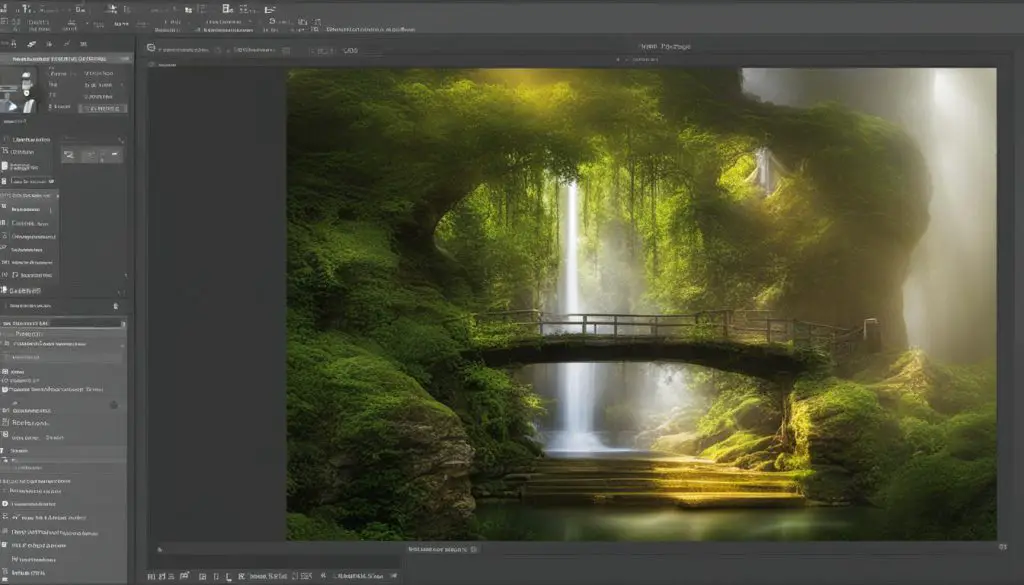Are you struggling to unlock TIFF files in Photoshop? Don’t worry, we’ve got you covered. In this step-by-step guide, we’ll walk you through the various methods to unlock TIFF files in Photoshop, allowing you to make edits and unleash your creativity.
Photoshop provides multiple options to unlock TIFF files. You can unlock individual layers by simply clicking the lock icon next to the layer’s name or using the forward-slash key. Additionally, you can unlock the default Background layer and make edits to it. Make sure to check your color mode settings to ensure your project is not set to use Indexed Color.
Unlocking layers in Photoshop can also be done using convenient keyboard shortcuts. By selecting the layers you want to unlock and pressing the forward-slash (/) key, you can quickly toggle the transparent pixels lock on/off for all selected layers. However, please note that this shortcut does not work for the default Background layer.
If keyboard shortcuts aren’t your thing, you can also unlock layers in Photoshop by clicking the lock icon located to the right of the layer’s name. Simply select the layer you want to unlock and click the lock icon. This method allows you to unlock the layer, make edits, and lock it again if necessary.
Now, let’s talk about the default Background layer. In Photoshop, the Background layer is locked by default. To unlock it, you have several options. You can click the lock icon on the Background layer in the layer tab, which will replace it with a new, normal layer called “Layer 0.” Another method is to double-click the Background layer and access a menu where you can rename it, change its color, and set other properties. You can also create a new layer from the background or copy the Background layer to preserve the original.
Opening TIFF files in Photoshop is a breeze. You can use the Open command or the Open Recent command to access your files. Additionally, you can open files from other Adobe applications like Illustrator, Fresco, Lightroom, or Bridge. Remember to specify settings and options in a dialog box if necessary. If a specific file format doesn’t appear, you may need to install the format’s plug-in module.
Unlocking TIFF files in Photoshop is a simple process that empowers you to make precise edits and changes to your images. Follow our step-by-step guide and utilize the keyboard shortcuts and lock icons to unlock TIFF files effortlessly. Unleash your creativity in Adobe Photoshop and bring your visions to life!
Key Takeaways:
- The lock icon and forward-slash key are practical tools to unlock individual layers in Photoshop.
- Remember to check your color mode settings to ensure your project is not set to use Indexed Color.
- Unlocking layers in Photoshop can also be done using convenient keyboard shortcuts.
- The default Background layer in Photoshop is locked by default, but you have various options to unlock it.
- Opening TIFF files in Photoshop is straightforward using the Open or Open Recent command.
Unlocking Layers in Photoshop Using Keyboard Shortcuts
To unlock layers in Photoshop quickly, you can use keyboard shortcuts. This method is efficient, saving you time and effort. Follow these simple steps:
- Select the layers you want to unlock by clicking on them while holding down the Shift key. You can also use the Ctrl key (Windows) or Command key (Mac) to select multiple layers individually.
- Once the desired layers are selected, press the forward-slash (/) key on your keyboard.
- The transparent pixels lock will be toggled off for all selected layers, unlocking them instantly.
Keyboard shortcuts offer a convenient way to unlock layers in Photoshop, allowing you to focus on your creative process without interruption. However, it’s important to note that this shortcut does not work for the default Background layer.
Unlocking Layers in Photoshop Using Keyboard Shortcuts
If you’re looking for a quick and efficient way to unlock multiple layers in Photoshop, using keyboard shortcuts is the way to go. By following these steps, you can easily unlock layers and make edits to your projects.
“Unlocking layers in Photoshop using keyboard shortcuts is a game-changer for productivity. It saves me so much time and effort, especially when working on complex projects with multiple layers. I highly recommend mastering these shortcuts to streamline your workflow.” – Professional Graphic Designer
Unlocking layers in Photoshop using keyboard shortcuts is a valuable technique that every Photoshop user should be familiar with. It provides a seamless workflow, allowing you to unlock layers with just a few keystrokes and focus on your creative process. Take advantage of this time-saving feature and unlock the full potential of your Photoshop projects.

Unlocking Layers in Photoshop Using the Lock Icon
One of the methods to unlock layers in Photoshop is by using the lock icon located next to the layer’s name. This method allows you to quickly unlock individual layers for editing. To unlock a layer, simply select the layer you want to unlock and click on the lock icon.
Once you click on the lock icon, the layer will be unlocked, and you can make changes to it as needed. This is particularly useful when you want to modify a specific layer without affecting the other layers in your project. To lock the layer again, you can select the layer and click on one of the lock options available in the layer options toolbar.
Using the lock icon to unlock layers in Photoshop provides a straightforward and convenient way to make edits to your design. This method is especially useful when you need to work on specific layers while keeping the other layers locked and protected.
| Lock Icon | Layer Status |
|---|---|
| Locked Layer | |
| Unlocked Layer |
Unlocking the Background Layer in Photoshop
In Photoshop, the Background layer is locked by default, preventing any direct modifications. However, there are several methods available to unlock the Background layer and enable editing. Let’s explore these options.
1. Clicking the Lock Icon
The simplest way to unlock the Background layer is by clicking the lock icon located to the right of the layer’s name in the layer tab. Select the Background layer and click the lock icon to unlock it. This action will replace the Background layer with a new, normal layer called “Layer 0.”
2. Double-Clicking the Background Layer
Another method is to double-click the Background layer, which opens a menu where you can rename the layer, change its color, and set other properties. This also automatically unlocks the Background layer, allowing you to make edits. Keep in mind that this method preserves the original Background layer.
3. Creating a New Layer from the Background
If you want to retain the original Background layer while unlocking it for editing, you can create a new layer based on the Background layer. Right-click on the Background layer and select “New Layer from Background.” This will create a new layer above the Background layer and unlock it for editing, while still preserving the original Background layer.
| Method | Description |
|---|---|
| Clicking the Lock Icon | Simplest method of unlocking the Background layer by clicking the lock icon in the layer tab. |
| Double-Clicking the Background Layer | Opens a menu where you can rename the layer, change its color, and unlock it for editing. |
| Creating a New Layer from the Background | Preserves the original Background layer while creating a new layer that is unlocked for editing. |
Unlocking the Background layer gives you the flexibility to make changes to the initial layer in your Photoshop project. Choose the method that suits your workflow best and start unlocking your creativity in Adobe Photoshop.

Opening TIFF Files in Photoshop
When it comes to opening TIFF files in Photoshop, you have several options at your disposal. One of the simplest methods is to use the Open command, which can be found under the File menu. By selecting this option, you can navigate to the location of your TIFF file and open it directly in Photoshop. Alternatively, you can use the Open Recent command if you have recently worked on a TIFF file and want to access it quickly.
Another way to open TIFF files is by utilizing other Adobe applications like Illustrator, Fresco, Lightroom, or Bridge. These programs allow you to import or open TIFF files directly into Photoshop for further editing. This seamless integration between Adobe software makes it convenient to work with various file formats, including TIFF.
It’s worth noting that depending on the specific TIFF file you are opening, you may need to specify certain settings or options in a dialog box before the file is fully loaded into Photoshop. This could include color mode, resolution, or compression settings. By adjusting these parameters, you can ensure that your TIFF file is opened correctly and ready for editing.
| Open Method | Description |
|---|---|
| Open Command | Use the File menu to navigate to and open your TIFF file in Photoshop. |
| Open Recent Command | Access recently worked on TIFF files directly from the Open Recent menu. |
| Adobe Application Integration | Import or open TIFF files from other Adobe applications into Photoshop. |
| Dialog Box Settings | Specify color mode, resolution, and compression settings if necessary. |
In addition to working with static images, Photoshop also supports the opening and editing of video files and image sequence files. This allows you to work with a variety of multimedia assets within the Photoshop environment. However, it’s important to ensure that you have the necessary codecs and plug-in modules installed for handling specific file formats.
With the ability to open TIFF files in Photoshop through various methods, you have the flexibility to seamlessly incorporate these files into your creative projects. Whether you’re a photographer, designer, or digital artist, having the ability to work with TIFF files in Photoshop opens up a world of possibilities for enhancing your images and unleashing your creativity.
Conclusion
Unlocking TIFF files in Photoshop is a straightforward process that grants you the freedom to make edits and enhancements to your images. By following the step-by-step guide and utilizing the keyboard shortcuts and lock icons, you can easily unlock TIFF files and unleash your creativity in Adobe Photoshop.
Whether you need to unlock individual layers, the Background layer, or open TIFF files in Photoshop, there are multiple methods at your disposal. You can unlock layers by clicking the lock icon next to the layer’s name or by using the forward-slash key on your keyboard. To unlock the default Background layer, you have options like clicking the lock icon or double-clicking the layer to access additional customization settings.
It’s important to note that while unlocking layers allows you to make edits, it’s essential to check your color mode settings to ensure your project is not set to use Indexed Color. Additionally, when opening TIFF files in Photoshop, you can use the Open command or open files from other Adobe applications like Illustrator, Fresco, Lightroom, or Bridge. Remember, if a file format does not appear in the Open dialog box, you may need to install the format’s plug-in module.
With these tools and techniques in your toolkit, you’re now equipped to confidently unlock TIFF files in Photoshop and take your image editing skills to the next level. So go ahead, unlock those TIFF files, and let your creativity soar!
